Leila Marie Lawler's Blog, page 29
February 23, 2019
{bits & pieces}
The weekly “little of this, little of that” feature here at Like Mother, Like Daughter!
(This will all look and work better if you click on the actual post and do not remain on the main page.)

I’m going with Baptist Fans for the quilting on this one.
Our links this week:
If you own a house built after the 70s, your struggle to make it pretty might not be just about paint color. It’s my humble opinion that the problem, the reason that a color palette that looks so wonderful in a magazine just doesn’t delight in your development house is… the trim.
Some people might never buy an old house the way I have done because they rightly know how much upkeep it is, how hard to heat, how lacking in amenities. But one thing old houses have: great trim on the doors and windows that makes decorating much easier. When you are looking at pictures of older (even really basic and almost primitive) houses, pay special attention to the trims. Note how when there is wider molding, it sets off the paint color well.
Even if it seems like it will cost too much, I suggest that replacing the stock 2 1/4″ trim in your house (links below for inexpensive ways to do it) will pay off in multiple cans of (not cheap) paint that you keep going back for, because your house just doesn’t ever reach that level you dream of. You could do one room at a time, or if you are able to, you can have the builder do it right to start with.
You don’t have to do “farmhouse trim” — there are other styles (and a quick search will reveal all the permutations) — but this style has the advantage of working well with the “colonial” houses builders tend to offer and most importantly, doesn’t involve expensive millwork or custom cuts. Look at this lady’s BEFORE post, very much like a million other hallways in America, including what looks like the layout not being quite right — and then the AFTER, where the new trim is superior to what you might find in a much more expensive house, just because this is where the builder cuts corners. Here Ana White gives directions. Here is a different sort of house, in Europe, where the trim was switched out for a “farmhouse” style, although there are no good “befores” to compare. It was looking at her Instagram that suddenly made me need to tell you all this!
Political correctness as taken over to the extent that we find ourselves forced to talk about sexuality as if it’s merely a matter of preference, like window trim. Here is an essay that explains it in terms of how God created us and what sexuality is for, and how misunderstanding these things can lead to idolatry. (The button to open the free PDF is under the author’s name.)
is a couple of years old, but well worth listening to. He takes his time, and things get really interesting around minute 45. He doesn’t get into advice about how to raise our boys to be manly until the Q and A, but it’s all worth listening to when you have time. One theme of his is that it’s not just softness that marks effeminacy — what we might call “macho” is also effeminate. A manly man is noted for his self-control and willingness to do hard things, especially for the sake of others.
Stella Morabito makes a solid case that soon we will be forced to accept pedophilia as just another personal expression, the objection to which will be classified as bigotry. Don’t think so? Well, you are probably at most two degrees away from a child who is being drugged and mutilated for gender ideology — something that was considered (and is) child abuse even to think of, not five years ago.
The remedy: not being afraid to talk to your family and friends about these things. If we are afraid to have conversations, we will have lost before the fight even begins. The St. Gregory Pocket is a perfect way to make this sort of community — enjoying this blog is a good common denominator! “Have you ever seen Like Mother, Like Daughter? Yes? Would you like to have a couples’ — or moms’ — reading group based on some posts and articles? Let’s do it! And we’ll bring you a meal when you have a baby!)
My friend Mark Langley explains why it’s a good idea to read Herodotus in high school. I appreciate that he gives an overview of what to expect in terms of digressions and ramblings — the first-time reader really does wonder if he is just not getting it! This is the edition Mark favors (despite his grumblings about the notes — great maps, he says): The Landmark Herodotus (I would recommend trying to find the hardback version if possible). (Affiliate link.)
Do you love baseball? Do you love comeback stories? Luke Hagerty, a lefty pitcher who had to quit 16 1/2 years ago due to his sudden inability to throw a baseball anywhere near where he wanted to go (a condition known as “the yips”), will head for spring training with the Cubs this spring — at the age of 37.
Our friend Thomas Mirus says, “A great, pointed send-up of the movement which, by the end of the first half of the 20th century, had destroyed classical music” (fortunately, country music remained untouched):
From the archives:
Auntie Leila answers a reader who wonders how to respond to anxious relatives as she and her family make changes to “live differently”: A Little Misunderstood.
Another reader would like to know if homeschooling will make her lose her mind.
I know I’m not posting much during the week — so just in case you missed it: How to choose a devotional, with help from Blessed Columba Marmion.
Today is the feast of St. Polycarp of Smyrna. “Polycarp had known those who had known Jesus, and was a disciple of St. John the Apostle, who had converted him around the year 80 AD. He taught, says his own pupil Irenaeus of Lyons, the things that he learned from the Apostles, which the Church hands down, which are true.” We live in a cloud of witnesses, if we but realized…
Early distant warning: March 1 is the feast of St. David, patron of Wales. I happen to be Welsh on my maternal grandfather’s side, but this feast always sneaks up on me. I hereby remind myself to make a dish with leeks for supper on Friday (I will opt for a meatless iteration), and to spring for a bouquet of daffodils to celebrate!
While you’re sharing our links with your friends, why not tell them about Like Mother, Like Daughter too!
We’d like to be clear that, when we direct you to a site via one of our links, we’re not necessarily endorsing the whole site, but rather just referring you to the individual post in question (unless we state otherwise).
Follow us:
Follow us on Twitter.
Like us on Facebook.
Auntie Leila’s Pinterest.
Rosie’s Pinterest.
Sukie’s Pinterest.
Deirdre’s Pinterest.
Habou’s Pinterest.
Bridget’s Pinterest.
Auntie Leila’s Ravelry.
Auntie Leila’s Instagram.
Rosie’s Instagram.
Sukie’s Instagram.
Deirdre’s Instagram.
Bridget’s Instagram.
Habou’s Instagram.
The post {bits & pieces} appeared first on Like Mother Like Daughter.
February 21, 2019
Choosing Lenten devotionals: Wisdom from Blessed Columba Marmion

Lent is approaching. (It begins on Ash Wednesday, March 6, in case you get taken by surprise like I do.) This penitential season brings with it the call to do more, to deepen our relationship with God. Let’s take a look at how to choose a devotional practice to achieve this goal.
Tuesday was one of those days when my Magnificat magazine’s meditation expressed some thoughts I’ve had about something; in this case, a troubling development in spiritual direction. (His words are not specifically about Lent, but Lent is coming, so we’ll apply them.)
The excerpt, from Blessed Columba Marmion, offers a guide — I think one especially important for women who are busy with so many cares and who are consumers of the many, many devotionals available and promoted on social media.
Although Marmion speaks here about Phariseeism, which emphasizes rules and adherence to form above God’s law — the subject of the Mass reading, Mark 8: 14-21 — what he says can also be applied to spiritual reading that manipulates one’s emotional state, causing us to make a connection between depth of spiritual progress and how we feel about it.
It’s the latter that concerns me now, because in our time sentimentalism, motivationalism (if I may coin a word for a particular genre), and the therapeutic dominate.
This is the passage (I’ve broken it up a bit for ease of reading):
We see how important it is in this matter to distrust our own judgment, our own lights; how important it is not to base our holiness upon such or such a practice of devotion, however excellent, which we choose for ourselves, nor upon such or such an observance of our religious rule.
Such an observance may be suspended by a higher law, as is, for example, the law of charity towards our neighbor. Holiness for us must be based before and above all upon the fulfilment of the divine law, the natural law, the precepts of the decalogue, the commandments of the Church, and the duties of our state.
A piety that does not respect this hierarchy of duties ought to be held suspect: all ascetism that is not governed by the precepts and doctrine of the Gospel cannot come from the Holy Spirit who inspired the Gospel. “Whosoever are led by the Spirit of God,” says Saint Paul, “they are the sons of God.”
Will you go through it again, line by line with me? Let’s see how Marmion can help us discern the helpful vs. the unhelpful.
We see how important it is in this matter to distrust our own judgment, our own lights; how important it is not to base our holiness upon such or such a practice of devotion, however excellent, which we choose for ourselves
On some level, all devotions are ones we choose for ourselves. Even if they are suggested by a spiritual director, well, we chose the spiritual director and chose to take his suggestions. Only the Liturgy is outside of this movement of our will towards or away from a particular devotion.
It’s not wrong to take practices upon ourselves (prayers, readings, penitential acts), but we have to have awareness that they are chosen by ourselves, and for our own sake, we need to have a healthy suspicion precisely of ourselves, because the self is not God. As important as it is to be careful of what we eat, it is immensely more important to be careful of spiritual food, which can be for our health or can lead to spiritual sickness.
nor upon such or such an observance of our religious rule.
This means that if you were a member of a religious order, or as a lay person, have taken upon yourself some rule (such as becoming a Third Order Carmelite or even imposing upon yourself something like “a mother’s rule of life”), it does not supersede God’s law. Religious life requires many little and big sacrifices of one’s own will under obedience, for perfection’s sake; nevertheless, charity and truth are always paramount:
Such an observance may be suspended by a higher law, as is, for example, the law of charity towards our neighbor.
If your children are sick, for instance, it’s the better part of devotion to tend to them, not rigidly to adhere to your prayers before the Blessed Sacrament. The mother of a family has the duty to see to it that they get supper. If the supper burns, it doesn’t excuse her that she was praying.
But let’s be realistic: I don’t think that most of us suffer from excessive adherence to our pre-planned schedule of spiritual development! The danger doesn’t lie there, I venture to say.
Most women today, reading this, are, much like me, trying to get some prayer, any prayer, into a life filled with unexpected circumstances and distractions and all-round busyness. And most of us aren’t over-schooled in self-discipline, either. We can’t help it, poor us. We are really quite comfortable and likely to remain so.
Here is his prescription:
Holiness for us must be based before and above all upon the fulfilment of the divine law
The divine law was summed up by Our Lord in the Great Commandment:
Thou shalt love the Lord thy God with all thy heart, and with all thy soul, and with all thy mind. This is the first and great commandment. And the second is like unto it, Thou shalt love thy neighbour as thyself. On these two commandments hang all the law and the prophets.
the natural law
The natural law can be looked at, briefly, in two ways.
One way is simply to acknowledge and respect the causes of things, meaning above all their ends or goals. For instance, the end or goal of eating is nutrition, and pleasure is a gift that goes along with that goal. If we make pleasure the first goal in eating, we go against the natural law. Children have to develop according to their natures; if we try to rush them or fail to help them in the way they require at the proper times, we go against the natural law.
The other way is expressed in the Cardinal Virtues, or virtues that can be approached and understood by reason, making them accessible to all. These virtues are Prudence, or right judgement; Justice, or giving each his due (including God and ourselves); Temperance, or self control and achieving the right order of things interiorly; and Fortitude, or the courage to do the Good.
You can see, even with this little explanation, how vast a field of devotion is open to us simply by naming these things! Reality itself is cause for joy; contemplating all these good things brings us far along in the spiritual life.
the precepts of the decalogue, the commandments of the Church
Marmion, having already mentioned the divine law, reinforces its importance with another reference to the Ten Commandments (the decalogue’s precepts, so frequently extolled in the Liturgy — pay attention to the Mass and the Divine Office and you will quickly realize how often we are exhorted to love the Lord’s precepts, to walk in his ways, to learn his commandments, to keep them, never to forsake them).
How often do we take to prayer the commandments of the Church? Her teachings regarding the different kinds of prayer and their importance for us, her expositions of the natural and divine laws, her exhortations to piety? What about just reading the Catechism of the Catholic Church?
Do the devotionals coming into our inbox or tempting us from the catalog emphasize this vital aspect of the spiritual life?
and the duties of our state.
The “state” of a woman with a husband and a family is the state of marriage. Do we think of that state as involving duties which it is in our spiritual interest to fulfill, or do we see it as either a sort of self-fulfillment exercise or even a burden — something we have to be talked into all the time, something we can’t confront or fulfill without constant pep talks and assurances that we will be left with a reasonable amount of freedom — that some part of our inner self will remain untouched?
Sometimes I think that women enter into this state freely and then spend the rest of their lives trying to escape!
Is this Lent’s devotional that we’re signing up for steeped in a spirit of helping us go deeper into our duties (which represent God’s will, remember!), deeper into the details of Holy Scripture, and deeper into life’s hierarchies, or does it pull us away by enticing us with visions of emotional fulfillment? Is it a “prosperity gospel” in that sense, that we expect a sort of transcendent realization in the now, discernible in our feelings?
The reality of a “state of life” (marriage is one, religious life is another) is that it, how shall I put this, curtails our scope of action for the purpose of a greater good; it’s precisely service to our fellow man (and child!). By necessity we must be curtailed! There is no other way to do anything of value! As long as every choice is open to us, we are in the condition of not having chosen. When we choose, we by definition limit the scope of what we can do — yet, paradoxically, we find our true creativity. If we seek creativity up front, we get personal destruction. Really creative persons — artists — know this. The form gives the real freedom.
You are probably waiting for me to quote G. K. Chesterton, so here you go!
Every act of will is an act of self-limitation. To desire action is to desire limitation. In that sense, every act is an act of self-sacrifice. When you choose anything, you reject everything else… Every act is an irrevocable selection and exclusion… The artist loves his limitations: they constitute the thing he is doing.
I think we could also say, “Every lover loves his limitations: they constitute the possibility of love.”
The difference between spurious and real spirituality is that the latter reminds us that suffering and self-denial are the essence of the Christian’s life, in the pattern set by the Savior. Suffering joined with Our Lord’s suffering bring us along the road of purgation — a Lenten road; the only road that leads to understanding (what the saints call illumination) and finally, union with God.
One’s state of life brings with it things that must be attended to. When we do so with love, this disposition in itself constitutes a devotion. Here is the heart of the mystery, to be accepted or rejected. If we allow ourselves to be led away from total self-giving to God’s plan for us (that is to say, to God), we allow ourselves to be led away from the offering of love. And that would negate devotion.
But attending to the things that pertain to your state in life frees you to love.
A piety that does not respect this hierarchy of duties ought to be held suspect
This observation is your tool of discernment, moving forward into Lent (or into whatever moment arises when we choose to go deeper in our spiritual life). Piety, the expression of devotion and worship, submits to the hierarchy, or ordering, of duties and indeed of life itself.
No doubt whoever is offering us a devotional is motivated by a desire to bring us closer to God — but will we end up closer if we fail to consider the claims upon us before embarking? Instead of a willingness to be led by feelings and emotions, our criteria should be tough-minded and yes, hold suspect anything that doesn’t turn us closer to our responsibilities.
all asceticism that is not governed by the precepts and doctrine of the Gospel cannot come from the Holy Spirit who inspired the Gospel.
Asceticism isn’t a word I’d apply to many — most — of the devotionals I see in the Catholic or broader Christian spiritual offerings today. I see very little in the way of denial of self, of helping the target audience identify the cross, take it up, and be heartened in knowing that in Christ, the burden is light.
We should be able to lean on trustworthy authority in the Church: bishops who are supposed to protect the well being of the faithful, guarding the flock against false shepherds and opportunists. Sadly, our protectors have fled the fold. Their indifference to the monetization of devotion — the rise of a spiritual marketplace teeming with self-proclaimed experts — seems even to be part of their plan; our pastors seem happy to outsource their duties, to engage surrogates for what ought to be accessible directly from them.
The Church is constituted to offer each person what he needs to be holy. But in our confused time it might not be easy to figure this all out. And let’s be clear: “results” — as has always been the case, as the martyrs testify — might not be discernible right away or even for quite a long time. As St. Paul says in First Corinthians, “But with me it is a very small thing that I should be judged of you, or of man’s judgment: yea, I judge not my own self.”
Being a Christian means grasping this hiddenness, accepting it, being willing to follow Him even in the darkness.
We can do hard things, my friends! Armed with knowledge (such as this truly helpful passage from Dom Marmion), we can fight this battle and win!
“Whosoever are led by the Spirit of God,” says Saint Paul, “they are the sons of God.”
The Spirit of God is not a vague, formless penumbra of an enabling and manageable deity. He is the Third Person of the Trinity. If we want to be one with God, we have to submit to His Spirit and not go our own way to seek affirmation apart from Him.
Luke 21: 36 Watch ye therefore, and pray always, that ye may be accounted worthy to escape all these things that shall come to pass, and to stand before the Son of man.
What do I recommend?
I don’t have any quick downloadable pretty ways to get spiritual enlightenment, nor have I done an in-depth survey of what’s available. It might take some work to find what is really good for you, in your present situation. Ideally you’d have a wise spiritual director, but believe me, I know how few and far between those are.
St. Joseph, St. Theresa of Avila tells us, is an admirable spiritual director when we can’t find a here-and-now one. Ite ad Iosef, as Scripture tells us — Go to Joseph — he has the vast stores from which he will protect us from famine.
I have a few suggestions — keeping in mind that Blessed Columba Marmion himself taught that prayer is at its core, conversation with God. So while my suggestions might not be easy, they are simple. It will take more work than just opening your inbox, but it will be uncomplicated in the sense that help is available and trustworthy when we remain connected to the tradition handed down to us.
The Magnificat magazine is tremendously helpful. Recently a new editor took over; I hope that they will stay beautiful and traditional in their meditations. I always enjoy the monthly essays on how the Church transformed the world, by Tony Esolen.
If you’re looking for a book about the Cardinal Virtues and how to grow in them that is broken down with questions that work well for a bookclub or reading group, I recommend Christopher Blum’s A Mind at Peace. (Affiliate link)
Here is a post about good spiritual reading from or about saints.
Here’s a post about living your Lent.
Definitely not quick and easy (but also, a very short book): My Lenten reading guide on Romano Guardini’s Spirit of the Liturgy. I think you — and your book group — could do it! I will help you and if you have questions, just leave them on the post and I will do my best to answer or find someone who can!
For the busy woman who wants a direct infusion of grace, maybe this is the season to delve into the Divine Office. You can download the Universalis app and have the daily Hours at your fingertip. This Lent, what about choosing one Hour (say, the Office of Readings — at the longest one it’s about 12 minutes) and make a commitment to pray it before you head to other destinations on the web.
We explain how to pray along with the universal Church in our book, The Little Oratory (affiliate link), by means of your own home altar. Honestly, if you haven’t made your own little oratory in your home, now could be the time — this Lent might be just the moment for you to do it!
Here is our very own St. Gregory Pocket Reading List — many of these suggestions would be edifying for Lent and work well with a reading group.
A few little notes that were too long to put in the main post:
I love my Magnificat magazine for the help it provides me to follow the liturgical year. The little meditations after the Mass readings often deepen my understanding, especially when they come from some holy man or woman from the past whose words have stood the test of time — it’s so easy to forget the treasury we have in the faith, or simply to remain unaware of the spiritual resources from the vast storehouse of wisdom.
The Marmion passage is from From Christ in His Mysteries, 11th Edition, Mother M. Saint Thomas, Translator.
The Mass reading (Mark 8:14-21) is the one in which Our Lord tells the disciples in the boat to beware the leaven of the Pharisees and the leaven of Herod. Just for our edification (I had to see what the Church Fathers said about this), the Venerable Bede teaches:
“…the leaven of the Pharisees is making the decrees of the divine law inferior to the traditions of men, preaching the law in word, attacking it in deed, tempting the Lord, and disbelieving His doctrine and His works; but the leaven of Herod is adultery, murder, rash swearing, a pretense of religion, hatred to Christ and His forerunner.”
John Henry Newman explains the ways in which it is reasonable to trust oneself, and the ways it is not:
Now, when it is said that to trust our own notions is a wrong thing and a vain wisdom, of course this is not meant of all our own notions whatever; for we must trust our own notions in one shape or other, and some notions which we form are right and true. The question, therefore, is, what is that evil trusting to ourselves, that sinful self-confidence, or self-conceit, which is called in the text the “wisdom of the world,” and is a chief cause of our going wrong in our religious inquiries? (This is both a rhetorical question and one which he answers in his sermon, The Self-wise Inquirer, also, on this topic, Religious Emotion.)
Honestly, once you just decide they are not too wordy and long, Newman’s sermons are the most wonderful spiritual reading… I know, hard to believe… but just try!
The post Choosing Lenten devotionals: Wisdom from Blessed Columba Marmion appeared first on Like Mother Like Daughter.
February 16, 2019
Greeting card giveaway with your {bits & pieces}!
The weekly “little of this, little of that” feature here at Like Mother, Like Daughter!
(This will all look and work better if you click on the actual post and do not remain on the main page.)

Do you love sending just the right greeting card?
I’m offering a sweet giveaway for two readers. One reader will receive a pack of three letter-pressed “Dominus Vobiscum” (“God be with you” in Latin) cards. Another reader would receive a pack of four assorted Catholic cards, (Mother’s Day, RIP, Confirmation, St. Valentine’s Day).

These cards are hand-drawn designs by Elizabeth Lemme — you can take a peek at her and see the array of pretty things she has.
Elizabeth says:
I’m a convert to Catholicism. I was led to Catholicism in part by studying Gregorian chant in graduate school! I joined my housemate’s schola and observed how beautifully chant wove into the liturgy. Then, I was toast after reading the Church Fathers, Chesterton, Robert Hugh Benson, re-reading Scripture, etc. I entered the church in 2007.
A little over a year after I entered the church, I entered a contemplative monastic order. One of my daily tasks in religious life was being a “House Calligrapher,” placing each Sunday’s Mass propers in prayer corners throughout the convent. The process involved Lectio Divina, silence, black ink, nibs and paper. I find it difficult to express in words how profound these little prayer corners were. Everywhere we walked, into the refectory, passing through the mailroom, reaching the stairwell, into the chapter room, everywhere, there was a little display set up of the calligraphed Word of God, candles, fabric, and fresh flowers.
I left the convent after four years, found my local FSSP parish, and joined the choir. That’s where I met the nice tenor who is now my husband! We still sing together in the same choir. Nick teaches music at the FSSP seminary, and I try to keep the home fires burning with our little ones, Anastasia (3) and Aloysius (1).
I haven’t lost the glow, though, from those powerful little convent prayer corners. The combination of calligraphy, scripture, the liturgical year, family life, iPhones, and the internet all inform my present efforts at creating both Catholic inspired greeting cards for handwritten correspondence, and illustrations/calligraphy for prayer corners.
It’s not really silent in family life, but I do my Lectio Divina as I’m able and still make the illustrations with drawing nibs dipped in black Japanese Sumi ink. I then scan the images to have a letterpress plate made. The plate is then stamped into cotton paper with a 1915 Chandler & Price Letterpress. It creates these incredible pillowy indentations into the paper.
My illustrations are inspired by the art of the Medieval, Early Renaissance, and Art Nouveau eras. Their stylized depictions seems to express the other-worldliness beyond our everyday surroundings. Studying the art of these eras has helped me to look at the ordinary things around me in a more extraordinary way.
And… my favorite part about working with black ink is that the fourth finger of my right hand is always stained, just like Jo in Little Women!

I think the Dominus Vobiscum cards would be perfect to offer as a gift to a priest. Or that card — as well as the Requiescat in Pacem (RIP) one — could be offered to a loved one with a Mass intention written inside!
The large heart design has an inscription from a 15th century English love poem that Elizabeth came across while searching for medieval carols and poems. It says, “For weal or woe I will not flee to love the heart that loveth me.”

These cards will be a work of beauty for the recipient to display, and well worth the expenditure when you think of it that way — you are sending art!
For a chance to win your packet, please leave a comment with your preference of the two choices — and if you like, some idea of what you would like to see in a greeting card!
Is there a special design or thought that you would like to see expressed? I know that I personally am longing for beautiful cards that tastefully wish the recipient greetings or congratulations on the reception of a sacrament. So many out there are too sentimental for my liking. These are lovely, don’t you think?

Visit Elizabeth’s to view her cards and illustrations. We will choose two winners by Thursday evening!
On to our links!
A conversation with Leila Miller about what she discovered when she asked adult children of divorce what their experience was. (The book is now FREE on Kindle!) You may know a couple in trouble; do not go along with what our society says, but offer a helping hand. Be on the side of their marriage. They need your help and most of all, so do their children.
I think I shared this essay before, but I find it worth re-reading, as the world turns and we come back to the same old rationalizations, despite their bankruptcy. Evil is persuasive precisely because it appeals to our laziness and refusal to have hope, the essence of the vice of sloth. Somehow we prefer wallowing in the mire to rising up and following the good. Prof. Christopher O. Tollefsen explains how false mercy is actually legalism, while loving God’s law makes man’s flourishing possible.
I’ve recently been learning more about Jerome Lejeune, the French doctor and geneticist who discovered the cause of Trisomy 21, Down’s Syndrome. Abortion is gaining ground. Many states are preparing against the day that the Supreme Court restricts or even overturns Roe v. Wade. People are being indoctrinated as never before about a perceived need to kill the unborn, especially if a defect is detected. Do we have a response to this utilitarianism? I really recommend that you read about Lejeune, read his “21 thoughts,” and if possible, watch this documentary about him. Here is the trailer.
Perhaps your parish could screen the documentary, or your mother’s group? He was a valiant and holy man who sacrificed his professional prestige to defend the unborn. “Today I lost the Nobel Prize,” he wrote, when he stood up before his colleagues and warned them of the coming evils of “prophylactic” abortion, totally in their hands as scientific professionals.
Speaking of quotes, this article about Sigrid Undset has some good ones, very thought-provoking. Even those who have heard of her and have read her novels don’t know that she was also a fine political and philosophical thinker. She grasped the danger of her country, Norway, having an established (Protestant) church and accurately prophesied its capitulation to the evils of Naziism. If you can ever find this book by Fr. Stanley Jaki, Sigrid Undset’s Quest For Truth, snap it up. Jeffrey Mirus has a long article here, offering a survey of Undset’s life and work, with more great quotes.
Our son-in-law John Folley has written about his journey from secure teaching post to working actively in building up a culture of beauty.
“Sex transitioning” is a one-way street, and children are being lured down it. It’s not right. In the 80s, when the problem of anorexia became acute, no one forbad therapists to help young people eat. But today, “therapy bans, originally designed to deny help for kids who seek talk therapy to end unwanted same-sex attractions, have now been expanded to deny help for kids who want to accept their biological reality.”
From the archives:
Perhaps you’ve been hearing more about ad orientem worship, a posture universally found in Christianity until about 60 years ago. I wrote about it here — in the context of a study of then-Cardinal Ratzinger’s (Pope Benedict) book Spirit of the Liturgy. I would suggest studying this book for Lent, which is coming soon!
Some thoughts on the kitchen in my Reasonably Clean House series!
Just for fun, looking over the post about the time I shored up a sagging leather cushion in my thrifted chair.
Today we celebrate two early saints, St. Juliana and St. Onesimus.
While you’re sharing our links with your friends, why not tell them about Like Mother, Like Daughter too!
We’d like to be clear that, when we direct you to a site via one of our links, we’re not necessarily endorsing the whole site, but rather just referring you to the individual post in question (unless we state otherwise).
Follow us:
Follow us on Twitter.
Like us on Facebook.
Auntie Leila’s Pinterest.
Rosie’s Pinterest.
Sukie’s Pinterest.
Deirdre’s Pinterest.
Habou’s Pinterest.
Bridget’s Pinterest.
Auntie Leila’s Ravelry.
Auntie Leila’s Instagram.
Rosie’s Instagram.
Sukie’s Instagram.
Deirdre’s Instagram.
Bridget’s Instagram.
Habou’s Instagram.
The post Greeting card giveaway with your {bits & pieces}! appeared first on Like Mother Like Daughter.
February 2, 2019
{bits & pieces}
The weekly “little of this, little of that” feature here at Like Mother, Like Daughter!
(This will all look and work better if you click on the actual post and do not remain on the main page.)
I’m really looking forward to speaking in Portland Oregon — are you anywhere near there? Could you come?
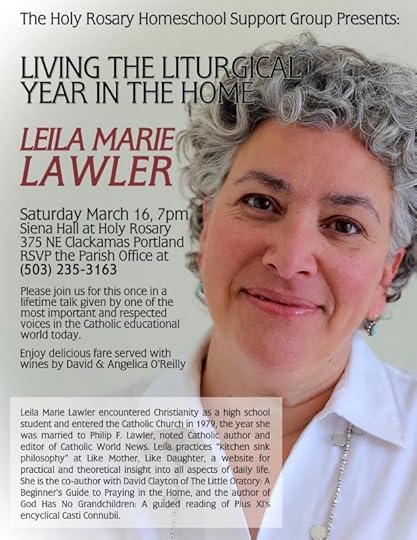
When I give these talks, I try to be sure that my listeners know that I’m not talking about anything stressful. Contrary to what you would suspect, making your Little Oratory and living according to the liturgical year calms your household.
I think that, when we order things towards prayer, we begin to learn that a humble beauty is best, one that draws us into a wordless communion with the spiritual life that connects heaven and earth.
So don’t imagine that I am all about inflicting a harsh regimen of baking and endless fun activities (though I do endorse cakes and fun), nor do I recommend seeking any sort of perfection that exists only in staged photos meant for social media.
On the contrary, I think — I hope — you go away feeling more content, more peaceful, and more committed to the long term of devotion in the home — the simple path that leads us to God.
Our links this week:
An Irish doctor has some strong words about modern medicine (the title is imbecilic but the article is great).
“What I am seeing every day on the wards doesn’t tally up with the narrative that we as a profession present to our patients and our politicians – which is that everything is getting better. We’ve come to believe that our core function in medicine is to cure everything, extend life as far as possible, prevent diseases by putting whole populations on drugs and into screening programmes.”
With a polar vortex our thoughts naturally turn to gardening. What do we think of this strawberry pallet planter, quite different from other ones I’ve seen? I have trouble with strawberries myself.
I had posted this link a few years ago; I think it’s good to bookmark it: Your rights during a miscarriage, from the Elizabeth Ministry International.
I have always wanted to whistle loudly to get attention. For a mom, this is a great skill — cuts down on the yelling. Also, could save your life in that situation that in my opinion is bound to happen sometime, getting lost on a hike. I need to study this: How to whistle loudly.
Amy Welborn on children in Church. I’m not sure about the book she references (to good effect), Mr. Blue. A friend kindly gave it to me once when I was convalescing from serious surgery, and that was so thoughtful. Maybe it was my post-operative haze that caused the narrative to fail to grip; in any case, it wasn’t my favorite. However, I very much appreciate what Amy says here. Someday I will write my own post on the subject, or maybe it will be a chapter in my book. I will say here that children can of course be at Mass, and attempts to keep them away or insist that they be front and center are both misguided and create false dichotomies. The best thing when we’ve lost our way so badly is to try to figure out what people did in the past and sort of take an average.
Fr. Schall (Who still lives! Amazingly! And writes!): Social justice, Judaism, and the primacy of the sacred.
Should medical professionals be neutral in matters of moral choice? What are the duties of those attending births — purely clinical? Read Pope Pius XII’s Allocution to Midwives (1951) — it’s a long read but it could absolutely be your morning meditation sometime this week. Far from the patronizing drivel we might expect a dignitary to bestow upon some visiting nurses, that Pope enters into a realistic and theological exposition of the role that the midwife plays in the life of the ordinary family, answering many tricky questions of sex education. Fantastic stuff.
Why was Karen Pence’s job in a Christian school suddenly a matter of national interest?
Did you or your kids go to the March for Life this year? Are you concerned that the March officials first caved to PC pressure from the media, without the slightest effort to ascertain the facts or consider their responsibility to underage marchers, then deleted to look into it (which obviously was step one), then, after days... and a threat of lawsuit… offered a less than satisfactory “apology”? I would think twice about sending anyone next year. If you are worried or even unsure, maybe let them know in their survey of marchers.
From the archives:
Go ahead and light those candles.
Speaking of sex education, since the Pope got on an airplane and called for sex education in schools while acknowledging the “filth” that programs include (including the one from the Vatican itself, although he doesn’t address that). Since what he says is often confusing, and in this matter he overthrows what was taught by Pius XI and John Paul II on the matter of how to educate young people, I offer you my essay, which is based on those teachings. I’m not the Pope, but we need clarity based on what has always been taught. (I didn’t choose the title, by the way.)
Today is the Feast of the Presentation, Candlemas! One of my very favorites!
While you’re sharing our links with your friends, why not tell them about Like Mother, Like Daughter too!
We’d like to be clear that, when we direct you to a site via one of our links, we’re not necessarily endorsing the whole site, but rather just referring you to the individual post in question (unless we state otherwise).
Follow us:
Follow us on Twitter.
Like us on Facebook.
Auntie Leila’s Pinterest.
Rosie’s Pinterest.
Sukie’s Pinterest.
Deirdre’s Pinterest.
Habou’s Pinterest.
Bridget’s Pinterest.
Auntie Leila’s Ravelry.
Auntie Leila’s Instagram.
Rosie’s Instagram.
Sukie’s Instagram.
Deirdre’s Instagram.
Bridget’s Instagram.
Habou’s Instagram.
The post {bits & pieces} appeared first on Like Mother Like Daughter.
January 26, 2019
{bits & pieces}
The weekly “little of this, little of that” feature here at Like Mother, Like Daughter!
(This will all look and work better if you click on the actual post and do not remain on the main page.)
I made a cap for Bridget for Little Christmas.

How many pictures of it do you want to see? (More on Instagram!)

It’s the “Giftie Slouchie Beanie” — a free pattern that I tweaked a little.

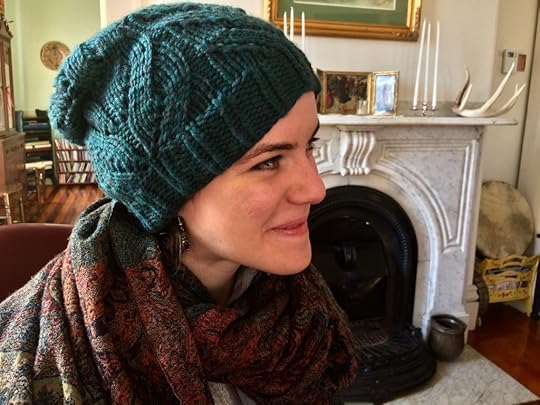
I twisted the knit stitches in the ribbing — I find that it makes for a stretchier and sturdier band.
I added another set of the lace pattern, because she wanted it to slouch and Lawlers have big heads…
… and I changed up the decreases at the crown because the way it was written didn’t make sense to me. Instead of one decrease in every lace repeat but not tracking with the lace pattern, in each row, I did two decreases tracking with the lace repeat (so k2tog and ssk at the beginning and end of each repeat, moving inwards towards the center purl stitch as the stitch count went down), every other row, with a knit round in between.
I think that makes a nice pattern that picks up on the rhythm of the lace.

The yarn is from Knit Picks. It’s called Rainforest Swish Bulky. Very pretty.
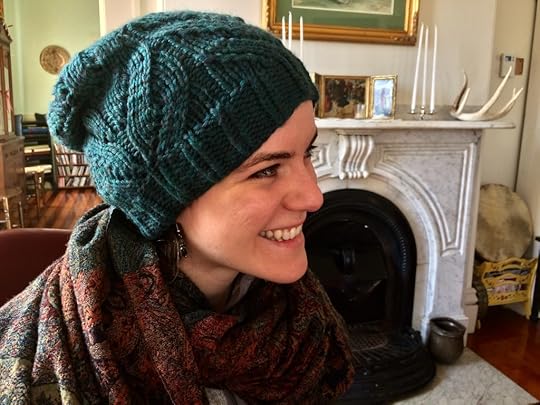
I will try to update my sadly neglected Ravelry account…
On to our links!
An article about everyday beauty in architecture. In my opinion, objective attributes of beauty have to be brought out to elevate the discussion above preference, but the article has some thoughtful ideas.
Delaying the newborn’s bath helps with breastfeeding. I used to be vaguely pro-delaying-the-bath but pretty sure it would be gross. Not at all! The baby can be gently wiped if necessary, and then his skin is so soft and fragrant — having now experienced this with my grandchildren, I can truly attest to it. Don’t be scared.
Robert Hugh Benson is an author worth pursuing. We love his Come Rack, Come Rope (I see that a Kindle version is free, which will hold you until you find a nice second-hand copy) for young people (8th or 9th grade and up); his spiritual reading is very helpful; I’ve written about his A Child’s Rule of Life here. Joseph Pearce remembers a forgotten giant.
For policy nerds: a reading list for countering the idea that socialism is a success in Nordic countries.
A long piece from Fr. Paul Scalia on the epiphany of celibacy; I suggest reading it as a prayerful meditation.
From the archives:
Weddings coming up? Here is a post about setting up your household, beyond the pots and pans registry. Maybe share with that bride-to-be?
Marie Kondo giving you an anxiety attack? But still need to get a handle on the housework? How about a Reasonably Clean House.
Hope for when you regret the past.
Sts. Timothy and Titus, bishops, pray for us!
While you’re sharing our links with your friends, why not tell them about Like Mother, Like Daughter too!
We’d like to be clear that, when we direct you to a site via one of our links, we’re not necessarily endorsing the whole site, but rather just referring you to the individual post in question (unless we state otherwise).
Follow us:
Follow us on Twitter.
Like us on Facebook.
Auntie Leila’s Pinterest.
Rosie’s Pinterest.
Sukie’s Pinterest.
Deirdre’s Pinterest.
Habou’s Pinterest.
Bridget’s Pinterest.
Auntie Leila’s Ravelry.
Auntie Leila’s Instagram.
Rosie’s Instagram.
Sukie’s Instagram.
Deirdre’s Instagram.
Bridget’s Instagram.
Habou’s Instagram.
The post {bits & pieces} appeared first on Like Mother Like Daughter.
January 19, 2019
{bits & pieces}
The weekly “little of this, little of that” feature here at Like Mother, Like Daughter!
(This will all look and work better if you click on the actual post and do not remain on the main page.)

Sukie and I were talking about how great it is to have a good planner and to-do list, but how perhaps misguided to have the sense that we must wake up in the morning very, very goal-oriented, or at least very aware that everyone else is goal-oriented and we are, by comparison, falling behind.
In this season of achieving all the things and decluttering all the things* and making sure we are bursting with explosions of creativity, all of which of course I endorse, maybe each day we might pause to think about how much it means to those around us to find us peaceful.
The drive to check off all the boxes can make normal things seem like obstacles.
I’m here to report that, just for instance, babies are not efficient…
… but that this inefficiency is a feature, not a bug.
In other words, I put for your consideration that the seeming pointlessness of daily life in making a home may be a result of our not having the vantage point necessary to see the whole. And these circumstances of life that seem so, well, not fabulously indicative of our self-realization and positively derailing of such, may be God’s way of helping, not hindering, us reach where we need to be.
I was also talking to my friend Therese yesterday, and she was lamenting how little direction we have from from our spiritual leaders, to know that we are not here on earth to perform to some worldly standard and become all we can be, this instant; but simply to do God’s will and be with Him in heaven.
And yet, each day is also full of things we need to do!
Today (as so many days) the Office of Readings (From a letter of Pope St Clement I to the Corinthians) explained the paradox well, and suited my theme:
It is obvious, therefore, that none of these owed their honour and exaltation to themselves, or to their own labours, or to their deeds of virtue. No; they owed everything to God’s will. So likewise with us, who by his will are called in Christ Jesus. We are not justified by our wisdom, intelligence, piety, or by any action of ours, however holy, but by faith, the one means by which God has justified men from the beginning. To him be glory for ever and ever. Amen…
… What must we do then, brothers? Give up good works? Stop practising Christian love? God forbid! We must be ready and eager for every opportunity to do good, and put our whole heart into it. Even the Creator and Lord of the universe rejoices in his works. By his supreme power he set the heavens in their place; by his infinite wisdom he gave them their order.
Read the rest of it (it’s short).
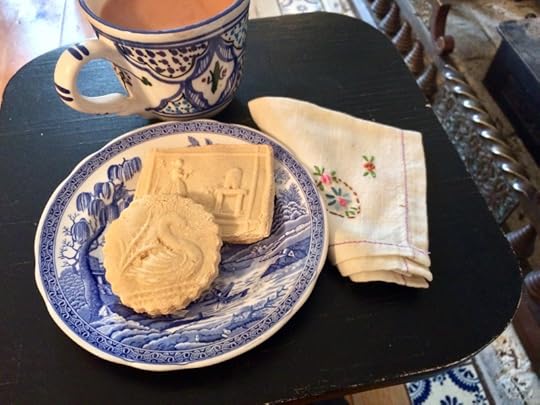
*But, on the other hand, if you are perchance decluttering and finding that your Springerle molds do not spark joy and you will never use them again, no matter how much Auntie Leila posts on IG about them, can you please contact me to make a deal? I will take them off your hands, with remuneration of course, mutually acceptable, if they fit into my plans. I feel that this whole decluttering movement could work in my favor…
On to our links!
I hate the term “toxic masculinity” and thought this rebuttal from a watch company to that awful shaving company ad, was moving and brilliant.
A little clarification from a respected physician on the topic of whether marijuana has been shown in medical studies to be helpful.
For those without a subscription, a few quotes:
Actual medicines have research behind them, enumerating their benefits, characterizing their harms, and ensuring the former supersedes the latter. Marijuana doesn’t. It’s a toxin, not a medicine. It impairs judgment and driving ability. It increases the risk of psychosis and schizophrenia. Smoking it damages the respiratory tract. A 2017 report from the National Academy of Medicine called the evidence for these harms “substantial.”
Some advocates say marijuana is better than opiates for pain. Yet while opiates have risks, there are no studies comparing them to marijuana, and untested claims in medicine don’t get the benefit of the doubt. Testing such a hypothesis often disproves it.
Decades passed before we took on smoking and drinking with education, labeling and other forms of regulation. But it worked, and deaths from lung cancer, heart disease and alcohol-associated accidents are in sharp decline. We need this same approach with marijuana. Acknowledging that it is not a medicine is a necessary first step.
A C. S. Lewis doodle! This one is on the Four Cardinal Virtues, a topic dear to my heart.
Do you know about the life and witness of Jerome Lejeune, geneticist and hero of the pro-life movement?
A reflection on the desecration of God’s temple.
Speaking of temples, Duncan Stroik, one of today’s foremost sacred architects, on the need for a new counter-reformation.
Kitchens of the Victorian period.
And what of beauty of buildings in general?
From the archives:
As the sad anniversary of Roe v. Wade approaches on Monday, here is what I wrote with my thoughts on marching, staying home, and healing a wounded nation: Marriage is the plan, there is no other plan.
Some little things that just make me feel housewifely (I remembered this post upon seeing a discussion on Facebook of how kids love wearing aprons to do their chores!)
Today there are some relatively obscure (yet of course appreciated!) saints on the calendar, St. Marius and family and St. Canute.
While you’re sharing our links with your friends, why not tell them about Like Mother, Like Daughter too!
We’d like to be clear that, when we direct you to a site via one of our links, we’re not necessarily endorsing the whole site, but rather just referring you to the individual post in question (unless we state otherwise).
Follow us:
Follow us on Twitter.
Like us on Facebook.
Auntie Leila’s Pinterest.
Rosie’s Pinterest.
Sukie’s Pinterest.
Deirdre’s Pinterest.
Habou’s Pinterest.
Bridget’s Pinterest.
Auntie Leila’s Ravelry.
Auntie Leila’s Instagram.
Rosie’s Instagram.
Sukie’s Instagram.
Deirdre’s Instagram.
Bridget’s Instagram.
Habou’s Instagram.
The post {bits & pieces} appeared first on Like Mother Like Daughter.
January 12, 2019
Elderberry cordial with your {bits & pieces}
The weekly “little of this, little of that” feature here at Like Mother, Like Daughter!
(This will all look and work better if you click on the actual post and do not remain on the main page.)
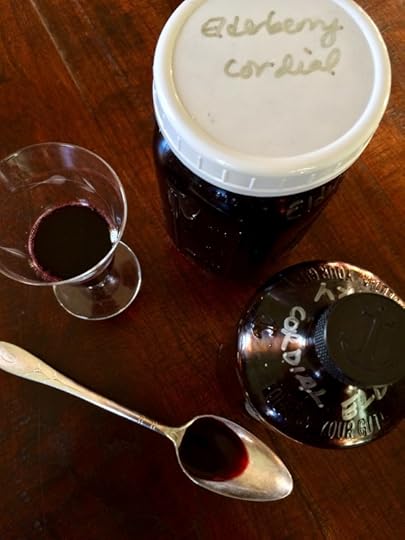
{Confidential to Becky, expecting your fourth: You apparently put the wrong email on the form — I am ready with an answer but can’t send it! Email me again!}
Wow, so much information in the comments to my UTI post! It’s so interesting to me how different people are and how one thing works for one person and another for another. One definite benefit to being connected online is that the knowledge base expands so much.
Long ago I had tried the cranberry cure (and the “100% pure cranberry juice, organic” version) to no avail. It does work for some! For me, what I posted works. You might find that another tip works for you.
The main thing is that it does not make sense to keep taking antibiotics (often the wrong one) for years. Some commenters noted that they are now being told to stay off antibiotics completely! This is a crazy situation to get into, because obviously we may need them for real at some point. But you can totally see how it happens. We just don’t have all the information we need (and that includes medical professionals). We really need to address the overuse of these important substances…
Anyway, thank you so much for chiming in! I find it all so fascinating.
Here’s another home remedy that I find works for me in preventing colds and making the ones I do get less severe:
Elderberry cordial.
Elderberries are very good for you and have been shown to be beneficial in preventing or treating many diseases (you can do a search for it on the NIH site if you want to read the studies).
You can make a syrup and leave it at that, but the cordial is so nice and Anne-of-Green-Gables-ish that somehow it hardly seems medicinal. In fact, I have developed a cocktail I call The Immunizer using it (I’ll have to do a post on my cocktails, most of which don’t pretend to be particularly healthy — meanwhile you can find it here on my Facebook). It’s nice by itself too. And a spoonful won’t hurt a child and may help them just drift off to sleep…

Here is my recipe (adapted from my friend Jennifer’s recipe that doesn’t call for boiling, but just for steeping for two weeks). The recipe is very flexible — I’ve added some things (like the hibiscus) that I think boost the goodness, but you can leave it all out if you want and just stick with the elderberries. It happened that I found the spices in the form of a half-price wine-mulling mix at my grocery store (and it was organic to boot), so I just opened that handy packet and was all set. If you don’t have all those spices, the ginger is the active ingredient.
Elderberry Cordial, Like Mother, Like Daughter
1¼ cups dried elderberries (I buy on Amazon — affiliate link — but am looking for a source out in the meadows near me!) You can use 2 cups of fresh elderberries if you have them. Do remember that the seeds of the elderberry are poisonous, so the straining step at the end is important.
2 tablespoons minced fresh ginger or 1 tsp. dried
1 stick cinnamon, crushed or 1 tsp. dried
1/4 cup dried rosehips
2 tablespoons dried orange peel or the fresh peel of one orange
1/4 cup dried hibiscus flower (also called Jamaica in Hispanic stores or Kerkaday in Middle Eastern stores)
Water to cover; about 3 cups
Boil/simmer these ingredients together for at least 3 minutes, up to about 10; let steep for an hour. Alternatively, you can steep them for two weeks in the jar with the brandy (below).
Strain well through a couple of layers of cheesecloth or a clean potato sack towel, pour into a large container or pitcher.
Add:
About 3 cups brandy
Raw honey, to taste (about a cup)
Mix well.
Decant into jars and keep in a cool dark place. I put the amount that we are going to be accessing in the near future into a dark bottle so it’s handy.
Take a teaspoon as needed (for children too), or a little snifter for you.
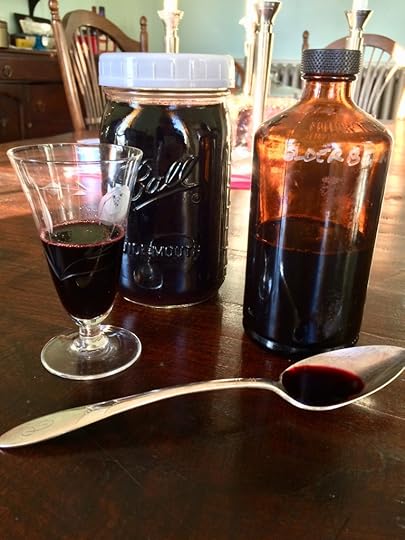
On to our links!
In honor of it still being Epiphany, I’d like to share my friend Michael Olbash’s presentation of a Lessons and Carols service at our church, St. John’s in Clinton. This is a most ambitious effort of his; the children from a small school, IHM in Still River, MA, assisted by just a few adult singers (including our Bridget whom you may spot in the video), offer under his direction a lovely time of prayer and singing. The motets are challenging! It just shows you what can be done (well, if you have someone with Michael’s talent and time to do it — but the kids did it too!). Here is the program if you ever wanted to try something like it next year…
Eve Browning of the University of Texas at San Antonio is working on a book about Xenophon. Seems a fascinating topic, judging by this article. I particularly enjoyed the part about the Phoenician merchant ship’s orderliness and Xenophon’s fictional narrator’s pleasure in domestic tidiness as well: “even pots appear graceful when they are arranged in a discriminating manner”!
Ever since I have understood the importance and unique quality of chant, I have been committed to helping others understand as well. Here is a great article to introduce you to the reasons this form is different and much needed in worship today (why other forms of music, no matter how beloved, can never be a substitute for chant). By the way, the “Swain” mentioned in the article is Joseph Swain, whose book Sacred Treasure (affiliate link) is a must-read on the subject (it’s so expensive, but perhaps a library near you has or could be persuaded to buy a copy).
Monsignor Pope on some common-sense Catholic teaching on some aspects of immigration. Whether you are pro- or anti-building the wall, it’s well to review these thoughts.
The St. Hildegard Abbey, a look at the continuation of the abbey begun by the saint (and doctor of the Church) herself.
Writing tips from Walter Benjamin. Like one’s health, some things work for some people and not all, but I found these tips food for thought about the writing process.
A Victorian Lady’s Guide to Cleaning Dresses of Muslin, Silk, Velvet, and Lace.
From the archives:
Some thoughts of mine on dating: for teens; for adults; how your marriage is God’s plan for preparing your children for theirs.
Getting some traction on your plan to get organized? Here’s how you make meals a little easier on yourself: Stash these 12 things.
It’s still the season of Epiphany; in the old calendar, two saints to celebrate: St. Hyginus and St. Theodosius.
While you’re sharing our links with your friends, why not tell them about Like Mother, Like Daughter too!
We’d like to be clear that, when we direct you to a site via one of our links, we’re not necessarily endorsing the whole site, but rather just referring you to the individual post in question (unless we state otherwise).
Follow us:
Follow us on Twitter.
Like us on Facebook.
Auntie Leila’s Pinterest.
Rosie’s Pinterest.
Sukie’s Pinterest.
Deirdre’s Pinterest.
Habou’s Pinterest.
Bridget’s Pinterest.
Auntie Leila’s Ravelry.
Auntie Leila’s Instagram.
Rosie’s Instagram.
Sukie’s Instagram.
Deirdre’s Instagram.
Bridget’s Instagram.
Habou’s Instagram.
The post Elderberry cordial with your {bits & pieces} appeared first on Like Mother Like Daughter.
January 8, 2019
How I cure a UTI without antibiotics
Some of us are prone to urinary tract infections or cystitis. It really stinks. You feel like you are going to die from the pain, and then you have to go sit in the emergency room or urgent care (because the symptoms always become acute at night, usually headed into a long weekend when the doctor is far away).
Then when you finally have the antibiotics in your hot little hand, it’s quite possible that they make you feel sick as well, and you have to recover from them.
I have discovered a way to treat a UTI without antibiotics. I will tell you exactly how, and then I will give you the reasons you might be having a recurring problem.
The list is towards the end of this post if you already know the details of this sickness. I wanted to put everything in one place for the sake of the collective memory (and really for my own reference as well), so this post is quite detailed.
But first I want to say that if you have pain in your side or back, which is where your kidneys are, high fever and chills, vomiting, and/or nausea , you do need to go to the doctor. If the UTI goes back into your kidneys you don’t want to do damage and end up in the hospital for a long time, so do pay attention to that.
Also, of course, I’m not a doctor! Or a nurse or anything at all.
But I have had a lot of these infections and I got sick and tired — and scared! — of taking so many antibiotics.
In my experience, a UTI makes me feel wretched and causes a LOT of pain, but I don’t get a fever (or it’s just a low-grade one). You might get a higher fever, because everyone is different, but if you have the other symptoms of a kidney infection, you need to see the doctor.
Burning, urinary frequency, the urge to urinate but passing only small amounts, blood in the urine, cloudy urine, a certain smell, pain in the pelvis — these are the symptoms of a UTI. It’s debilitating and makes you panic.
The antibiotic will usually take care of the bacteria, true. If it is an infection, that is. It could also be inflammation and irritation that may or may not develop into a UTI — and so all the more reason to be wary, because of course, we all should be taking fewer antibiotics!
So if given the choice between taking antibiotics and not taking them, with the same outcome, of course we prefer not to take them. (I have also noticed that sometimes a rather weak antibiotic is prescribed, which lends credence to my theory and experience that it can be cured without one at all.)
But even if you want meds, it’s not so easy, is it!
If you have this problem, you know the drill — you painfully drive yourself to the office or ER and that takes hours, all while you feel like the fires of Hades are in your nether parts.
You get the dip test, it comes back positive, they send the culture out for further tests to match with the kind of bacteria you have (more than 90% sure it’s E. coli however), and meanwhile you go on the antibiotic which may or may not be the right one.
I’m allergic to penicillin so that whole category is out. That means they give me Cipro, which has disturbing side effects.
Plus, UTIs end up scarring the tissue in your urethra, so you are only more prone to them as time goes by, increasing your dependency on antibiotics. This is so unfair.
Now that I am part of a cost-sharing plan, I have a further incentive, beyond not wasting time and agony sitting around waiting to be treated: I also don’t want the people in my sharing plan to pay for those tests and that visit when I already know what is wrong with me. (Not that you aren’t paying when you have insurance!)
Maybe if they just prescribed the only antibiotic I can take anyway over the phone, I wouldn’t have been so motivated, but those days are gone, when the doctor would just help you without the insurance rigamarole. But then, so many courses of antibiotics… it’s not good.
So I needed another way!
Try this treatment (with the caveats above!) — it has worked for me twice now, and both times I’ve been in extremis with awful pain and bloody urine.
Thanks to Sukie telling me about it, I discovered that there is a sugar, D-Mannose, that has a molecular structure that bonds with E. coli, the bacteria most responsible for UTIs.
Thanks to Deirdre’s midwife, Cindy, I found out about Marshmallow Root, which provides mucilage and soothes smooth muscle, including in the urinary tract.
You need to address the pain. One time I took ibuprofen only for the pain; this last time I also took AZO (or the generic equivalent). It turns your urine bright orange (and don’t touch your contact lenses without washing your hands!) but it takes away the pain.
And that is the key!
Once you feel that the pain will be taken care of, you can do what needs to be done, which is to force liquids so that you can urinate copiously and wash away the bacteria that have bonded with the D-Mannose.

Non-antibiotic remedies for a UTI — in the foreground are the hibiscus and the spoon with the D-Mannose, which also comes in capsules. (That spoonful represents the very last bit I have of the powder; I found the capsules at a DNC while we were on the road. Next time I will pack the essentials so I don’t have to search while in pain!) The tea in the box is hibiscus and rose hips, which I can often find at Marshall’s.
UTI Natural Treatment Protocol of Effectiveness:
Take the pain killers (affiliate link) according to the dosages. (This is not the natural part, but thank goodness for ibuprofen and AZO.)
D-Mannose. (affiliate link) This is a sugar, the molecular shape of which bonds with the bacteria. You don’t need it in pill/capsule form — it’s sweet! Just buy it as a powder and dissolve a teaspoon at a time in a small amount of warm water. It will work best if you give it a chance before diluting it in your bladder with all the fluids you are going to need to drink. So as soon as you are able, take that dose, then wait for about half an hour, then begin the super hydration.
Take one teaspoon about three times a day. You are aiming for 3 grams a day, so go by the amount per dosage listed on the container and spread it out over the day. It might have the effect of loosening your bowels; if so, cut back. It doesn’t always, I have found.
Begin hydrating. Besides water, also try hibiscus tea (called Kerkaday at Middle Eastern markets and Jamaica at Hispanic markets if you can find it in bulk — much cheaper that way). You can drink that cold, warm, or hot, and it’s delicious. It is related to Marshmallow Root so may have the same effect on the mucus membranes — it’s also just very healthy with plenty of vitamin C and antioxidants. Buying it in bulk is much cheaper than buying it as tea bags, and it usually comes as dried flowers, which are large and easy to brew.
You can drink your kombucha too. Just drink! Drink a lot!
Midwife Cindy’s colleague, an OB/GYN who has now retired, recommended that a UTI sufferer take a large container of water and a cup into a very warm bath. Cindy explains his thinking: you are afraid to pee because it hurts so much; the bath relaxes you, you can drink from your container (a pitcher with two quarts of water), you can pee in the bath, who cares.
I haven’t done that but I have used a heating pad across my pelvis and my drink next to me so I force the fluids.
Marshmallow root. (affiliate link) This comes in capsules unless you grow your own or find it in bulk somewhere to make into tea. You need to take two capsules four times a day. That’s a lot of swallowing! Keep at it.
Vitamin B6. This can help with urination.
Mullein. (affiliate link) Last year I dried mullein from my yard. This plant, dried and made into a tea, helps with many infections, but it has many spiky fibers that you will need to strain out with a cloth so that you don’t irritate your bladder and urethra. It’s worth it, though, I think. I used mine all up defending against colds and my UTI last time; you can get by without it until you observe the plant in some weedy patch next year.
Raw honey. Real raw honey that hasn’t been filtered has antibiotic properties. Take a teaspoon a couple times a day and also sweeten your hibiscus tea with it.

This is mullein — it’s a huge weed, easy to spot. Instead of paying out big bucks for it, just go yank it up when you see it, wash and dry the leaves, flowers, and roots, and make your own teas from it. Info is readily available online.
After you feel better, Cindy recommends continuing with the Marshmallow root for a few days.
I recommend having all these things on hand in your cupboard — and traveling with them as well, because it does take a bit of effort to round them up. At least the AZO, D-Mannose, and Marshmallow Root. Make yourself a UTI kit and keep it handy.
You might as well try it! It’s a lot cheaper than going to the doctor/ER and you can always go later (by which I mean in the morning when the doctor’s office is open) if you need to.
For ongoing care to avoid UTIs/cystitis:
You can take the D-Mannose on a regular basis, maybe just a teaspoon a day. Mix it into your tea or coffee or take it with warm water. It works better if it can sit in your bladder, so take it at a time that you are not as well hydrated, say, first thing in the morning with your first cup of tea.
Be better about staying hydrated. Have a set amount that you will drink all day, or certain times that you stop and have some water, iced tea, or kombucha; don’t let yourself feel parched; if you do feel parched, get a big drink right away — don’t just continue feeling that way for an hour.
Your urine needs to be a light yellow in the morning — you should barely see it. If it’s dark, you are not drinking enough.
Urinate before and after intercourse and make sure you’re hydrated.
Wipe front to back when you go to the bathroom. Don’t wear undies that are made out of anything other than cotton in the crotch.
Don’t use those menstruation cups that fit inside your vagina. The pressure of the rim of the cup presses against your urethra and can cause a backup of the bacteria that cause UTIs.
By the way, little girls can get UTIs too. I have a friend whose 10-year-old daughter was not doing well for days, acting listless and tired. She realized that the girl had a very low temperature when she finally thought to take it at different times of the day. The doctor was then called and the UTI diagnosed. Just something to have in the back of your mind… Children need to be reminded to drink at regular intervals too!
NB: I also want to say that the one thing you usually hear — drink cranberry juice — is not actually that effective or the best thing to do. It’s not effective because the active ingredient that helps you (the D-Mannose) is too diluted in the juice. It’s not the best because it’s so acidic that it is going to inflame your urethra and/or bladder more, causing more difficulty.
I hope this information helps you! Do you have any ways you avoid a UTI without antibiotics? I’d love to know!
The post How I cure a UTI without antibiotics appeared first on Like Mother Like Daughter.
January 5, 2019
{bits & pieces}
The weekly “little of this, little of that” feature here at Like Mother, Like Daughter!
(This will all look and work better if you click on the actual post and do not remain on the main page.)



I know that “themed” trees and decorations are a thing (and can be so pretty!), but for us, the special ornaments collected and made over the years are a significant part of the warmth we experience at Christmas. Our children have always loved getting them out and remembering where they came from or when they were made, and now our grandchildren are becoming familiar with them too.
These are a few — you can view more on Instagram where I thought it might be fun to round them up (hardly all, though — maybe I’ll do another post over there*!) and share. Christmas is not over! We are still enjoying our well loved decorations (and eating our treats!).
*If you are interested, my Advent and Christmas posts over the years have always featured our modest but beloved decorations!
On to our links!
Versailles from hunting lodge to Revolution aftermath, in virtual reality.
Flannery O’Connor reads A Good Man is Hard to Find (and a link to 900 free audio books).
Colorized photos of Ellis Island immigrants.
A site that organizes the writings of the Church Fathers according to various topics. Want to know what the early Christians virtually unanimously held on a given topic, for instance, Mary’s perpetual virginity? This site can help.
Christians of course must evangelize. There is a whole industry out there devoted to telling us how to do it, but I find that what is neglected is the understanding that we must live as persons who love God in order to make God’s love known. Cardinal Newman (to whom I have recourse often to escape the aforementioned industry) has some simple guidelines — very good for the New Year resolution trap too.
As we begin to turn from the Christmas mysteries towards the next days in the liturgical year, let us not go without another thought for Joseph. Very soon (I will try to remind you), we will begin the Seven Sundays devotion to that beloved figure (it always begins on Super Bowl Sunday, actually!). Perhaps a good book for spiritual reading, especially if you are suffering from what has come to be called a father wound (and our whole society, I think, is suffering in this way), would be this one, which I found of great value: Saint Joseph, Shadow of the Father. Sadly, it is now out of print; I’m linking to an image of it so you can snap it up if you see it at a sale.
And one more beautiful reflection on Christmas — and St. Therese’s “second conversion” — before we bid the season adieu.
An important book review about “trans” regret from Stella Morabito. Maybe there is someone in your life who is trying to “transition” — and you are being silenced as to the abuse and manipulation that is going on. This review and book can help — it’s real stories from real people. Behind any attempt to change a person’s sex (which after all is a genetic reality, no matter what anyone says) we will always find many issues that need addressing. The vast majority today are due to family disruption and are healed in short order when these underlying problems are brought to light and taken care of. Let’s support each other and help each other grow according to our natures, not against them. (If you click on the “transgender” tag on this post you will find lots of other resources.
Free books, periodicals, music, and movies now available online. Maybe the St. Joseph book will appear at some point!
From the archives:
Sometimes I think, “Oh, I should write a post about that” and then quickly I think, “I did!” Some posts came to mind this week:
Do you just not know how to give your children the gift of innocence and purity in today’s world, though you are desperate to heed admonishments that you try? Many will tell you to do it; only I will tell you how to do it and exactly what to do. (Only by the grace of knowing others who have figured things out — I’m the messenger, and an imperfect one at that!)
All set to make all the lists? But also feel a bit of planner commitment anxiety syndrome (PCAS)? My way; Deirdre’s way. My tidy desk (hmm… that was a while ago, need to revisit). Deirdre’s. Both of these involved thrifted/picked up on the side of the road items! BONUS: How to keep a binder to track your home school. Very old fashioned but I think it works for the reason that it’s something solid you can add to easily and flip around in later when another child comes up, also, and quite unreasonably you might be thinking, needing to be educated.
Want to simplify your life (and make it cleaner) but really feel like the advice is not geared towards a busy family that may or may not be homeschooling, working from home, and otherwise using every spare minute of their day trashing their house (vs. having few children and leaving the house untouched most of the day)? I have posts for that. A series, actually, which many people have found helpful. Just start at the beginning. I will help you. (That said, I need to watch those Marie Kondo videos that just came out!)
Today is the feast of St. John Neumann. He died from exhaustion, collapsing on the street at a young age as he ceaselessly made the rounds of his vast diocese, consumed with care for the souls entrusted to him. Pray for his intercession for our bishops as they continue their retreat and head into the “Vatican summit” on the current crisis.
While you’re sharing our links with your friends, why not tell them about Like Mother, Like Daughter too!
We’d like to be clear that, when we direct you to a site via one of our links, we’re not necessarily endorsing the whole site, but rather just referring you to the individual post in question (unless we state otherwise).
Follow us:
Follow us on Twitter.
Like us on Facebook.
Auntie Leila’s Pinterest.
Rosie’s Pinterest.
Sukie’s Pinterest.
Deirdre’s Pinterest.
Habou’s Pinterest.
Bridget’s Pinterest.
Auntie Leila’s Ravelry.
Auntie Leila’s Instagram.
Rosie’s Instagram.
Sukie’s Instagram.
Deirdre’s Instagram.
Bridget’s Instagram.
Habou’s Instagram.
The post {bits & pieces} appeared first on Like Mother Like Daughter.
December 29, 2018
An end-of-year retrospective and a little looking ahead, with your {bits & pieces}
The weekly “little of this, little of that” feature here at Like Mother, Like Daughter!
(This will all look and work better if you click on the actual post and do not remain on the main page.)

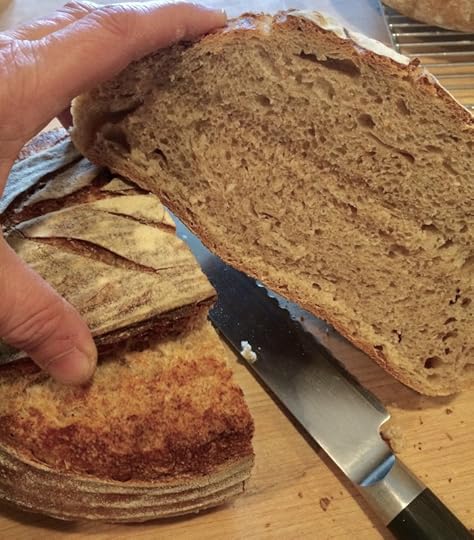
(My bread is getting better — have you been making sourdough?)
Let’s do a little end-of-year retrospective, shall we?
The top ten most popular posts here this year (in a manner of speaking — a couple of them could be thought of as “controversial posts that got a lot of traffic” although beats me what is so incendiary after all) — some from this year and some from past years, due to our decreased blogging schedule:
This little post right at the beginning of 2018, in which I did no more than reiterate the very themes and purposes of this blog, only to find myself in quite the firestorm (mainly fueled by willful misinterpretation of what I wrote by some who cravenly put their own words in front of partial quotes from mine or who shared said misrepresentation — a discreditable practice that should cause a complete loss of reputation in the absence of contrition and reparation).
Mrs. Piggle-Wiggle was apparently the hill I would be dying on next, but I’m happy to do it. In this post I deplored — and I still deplore — the bait-and-switch tactics that adults perpetrate on young people. Draw them in with the fun, corrupt them with the agenda.
At the bottom of our site there is a widget that shows you what people are looking at “now” — it always amuses me that my post on how to cope with your almond bathroom fixtures is usually on it! But for real — not everyone can rip out all the fixtures and start from scratch. Who has $30,000 just lying around? But bathrooms need to be updated! Well, I did solve this one problem for you, so you’re welcome.
The Reasonably Clean House — this post is actually a collection of the whole series I did back in the day. This is what you need to stop ricocheting around the “boom or bust” methods you may currently employ. Let’s be honest, the only way to have a Perfectly Clean House is to get rid of the children or at least stop educating them, and just “blessing the mess” doesn’t cut it, because we’re actually happier when things are reasonably clean!
Easy and Good Pot Roast. Nothing controversial there, but a secret ingredient I bet you hadn’t thought of, and no, it’s not a packet of ranch dressing.
Taking Care of Children when They are Sick — don’t go to the doctor for every little thing, and don’t wait for a child to collapse, either. The Collective Memory for when you need to put on your nurse’s cap.
Deirdre explains more about Samaritan Ministries, the Christian cost-sharing plan you join instead of paying a mortgage-sized amount to an insurance company that may or may not cover your health bills. I am a member as well, and a huge fan.
Restoring sanity and helping people get married. Reflections inspired by a documentary on dating that Deirdre and I saw.
One post I worked hard on and hope will be helpful to you in the coming year: A book (and other reading) list for the St. Gregory Pocket! Which of course you will be starting, or joining, or reviving, or continuing to enjoy, because friendship is the way forward in this crazy world of ours! (I just got an email from a gal who found some kindred spirits this way — these other ladies had been involved in a St. Greg’s Pocket but it was too much of a drive for them, so they started their own, and good thing they did, for my correspondent!)
And of course, my friend Amy Fahey’s recommendations for children’s books –– now that the Christmas rush is over, it might be easier to track some of these down through used book vendors. By the way, a friend of mine has a great book shop on Etsy. I am always tempted by her offerings when I see them on Instagram! But how many books do I need? (Rhetorical question, I need all the books.)

Another list: Things I want to know more about this coming year:
Always wanting to know more about sourdough.
Kombucha. Tell me your ways. A friend gave me a scoby and it is currently languishing in the cupboard, pending my increased learning curve. Tell me why it’s not just… vinegary tea…
Banjo. I am trying to learn, though the holidays interrupted my groove. Also, it’s way heavier than I thought it would be. But Nick gave me some online lessons for Christmas so… I’m on it. My hope is that someone, anyone, in my family will decide that he can do it better… but one way or another, we need a banjo player! I mean, I can strum some chords, right?
Not a New Year’s thought, but I have a favor to ask:If you loved The Little Oratory, would you consider going over to Amazon and leaving a review? It helps bring it to people’s attention as they are buying related books. I recently was reminded of this book by Robert Hugh Benson (whose book A Child’s Rule of Life I had written about at one point) — isn’t it darling? Fits perfectly with our “living the liturgical year in a traditional way” encouragement.
What are you hoping to accomplish in the coming year? Remember, behind your resolutions are these two keys to actually making any changes.
Today is the feast of Thomas à Becket, bishop and martyr. Our friend Tony Esolen wrote a piece about him that weaves in the flavor of medieval culture and insights into the meaning of the university. And Fr. C. J. McCloskey wrote about how this saint is a role model for bishops.
I want to say how grateful I am for all our readers! We really love you and cherish each one of you, the ones known to us with many or few comments and interactions, and the ones who just silently follow along.
Every once in a while someone from that latter group emails me, and it never fails to brighten my day — to hear “I don’t ever comment but I love the blog and have learned so much” — this is why we are here! We learn from you too, and are very happy to be able to welcome you here to our little internet home.
Merry Fifth Day of Christmas — and a Happy New Year!
While you’re sharing our links with your friends, why not tell them about Like Mother, Like Daughter too!
We’d like to be clear that, when we direct you to a site via one of our links, we’re not necessarily endorsing the whole site, but rather just referring you to the individual post in question (unless we state otherwise).
Follow us:
Follow us on Twitter.
Like us on Facebook.
Auntie Leila’s Pinterest.
Rosie’s Pinterest.
Sukie’s Pinterest.
Deirdre’s Pinterest.
Habou’s Pinterest.
Bridget’s Pinterest.
Auntie Leila’s Ravelry.
Auntie Leila’s Instagram.
Rosie’s Instagram.
Sukie’s Instagram.
Deirdre’s Instagram.
Bridget’s Instagram.
Habou’s Instagram.
The post An end-of-year retrospective and a little looking ahead, with your {bits & pieces} appeared first on Like Mother Like Daughter.



